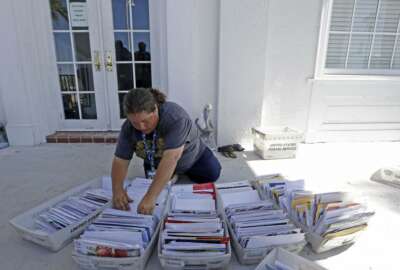
Postal Service forecasts ‘much-needed revenue’ from approved rate hike
The U.S. Postal Service reported its 11th straight year of financial losses on Tuesday, but a number of pending regulatory changes could, in time, help put the ...
Subscribe to Federal Drive’s daily audio interviews on iTunes or PodcastOne.
The U.S. Postal Service reported its 11th straight year of financial losses on Tuesday, but a number of pending regulatory changes could, in time, help put the agency on a path toward solvency.
The Postal Service delivered 589 million more packages in FY 2017 than it did the previous fiscal year — an 11.4 percent growth rate in a business sector where USPS has routinely seen double-digit growth. However, USPS also delivered 5 billion fewer pieces of mail in FY 2017, a 3.6 percent decrease from the previous year.
“This decline puts significant financial strain on the organization,” Postmaster Megan Brennan told reporters during a conference call Tuesday. She added that USPS’ letter and mail shipping business contributes to more than 70 percent of its yearly revenue.
Despite the continued growth of its package delivery business, USPS ended fiscal 2017 with a $2.7 billion loss, down from a $5.6 billion loss in fiscal 2016.
Chief Financial Officer Joe Corbett told reporters during the call that USPS had been following an “accelerated rate” of first-class mail decline throughout FY 2017, which is especially troubling considering first-class mail has a high-profit margin for the agency.
The Postal Service also defaulted on more than $6.9 billion in payments to pre-fund future pension and health benefits for postal works, a requirement outlined in a 2006 postal law.
“Making these payments in full or in part would have left us with insufficient cash on hand to ensure that we will be able to cover our current and our anticipated operating costs, make necessary capital investments and have adequate liquidity,” Corbett said.
Amid the harsh reality of the Postal Service’s financial situation, Brennan also thanked the Postal Regulatory Commision, USPS’ oversight board, for approving the agency’s proposal to increase prices for a number of its products next year. Effective Jan. 21, 2018, the Postal Service will raise the price of a first-class postage stamp to 50 cents — an increase of 1 cent — and will introduce an across-the-board 5-cent increase on flat-rate postal products.
Brennan said the new pricing structure will provide the Postal Service with “much-needed revenue to help fund our operations.”
In addition, the postmaster general thanked the Trump administration for announcing in October three nominees — Calvin R. Tucker, Robert M. Duncan and David Williams — to serve on USPS’ board of governors, which currently has no appointed members. The last member of the board stepped down in December 2016, after his term expired.
“We are best served by a fully constituted board made up of well-qualified individuals with diverse perspectives and experience. We urge the Senate to confirm governors to fill the current vacancies,” Brennan said.
Brennan also gave special thanks to letter carriers nationwide for maintaining a consistent level of delivery service after hurricanes Harvey, Irma and Maria devastated the Gulf region and Puerto Rico, and an unusually severe wildfire season impacted the West Coast this summer.
“In the past few months, both our customers and our employees have dealt with the disruptions and the devastation,” Brennan said. “We appreciate the dedication of our employees during these very challenging circumstances. They focused on customer needs and brought a sense of normalcy back to their communities.”
Beyond the price changes already set to take effect in January 2018, postal leadership is also waiting on the PRC to conclude its 10-year review of the postage rate system, which is expected to happen this fall. Depending on its verdict, the PRC could allow USPS more flexibility to set postage prices beyond the rate of inflation, and could raise the cost of a first-class postage stamp to as high as 60 cents.
The Postal Service is also calling lawmakers to put a bipartisan postal reform bill to a full House vote. The bill would give USPS even more price flexibility and reduce the burden of legislative requirement to prefund pensions and health benefits for postal retirees. The bill passed the House Oversight and Government Reform Committee in February.
“Without these changes, our financial results will continue to deteriorate, and likely at an accelerating rate,” Brennan said. “Simply put, absent legislative and regulatory change, we cannot generate enough revenue or cut enough costs to pay all of our bills.”
Fredric Rolando, president of the National Association of Letter Carriers postal union, said that fixing the pre-funding and pricing issues is critical.
“Addressing these external financial burdens would allow USPS — which is based in the Constitution and which enjoys broad public and political support — to continue providing Americans and their businesses with the industrial world’s most affordable delivery network,” Rolando said in a statement on Tuesday.
Despite the 2018 rate hike, Brennan said USPS is focused on driving down costs by right-sizing the scope of its processing and delivery infrastructure, based on trends in volume for mail and packages.
This holiday season, USPS expects to deliver more than 15 billion pieces of mail, including more than 850 million packages, an increase of more than 10 percent from last year. In order to meet demand, USPS will have postal workers delivering packages on Sundays in December, and will phase in more early morning and evening package deliveries.
Copyright © 2024 Federal News Network. All rights reserved. This website is not intended for users located within the European Economic Area.
Jory Heckman is a reporter at Federal News Network covering U.S. Postal Service, IRS, big data and technology issues.
Follow @jheckmanWFED
Related Stories





